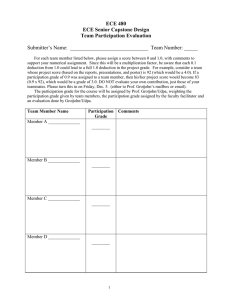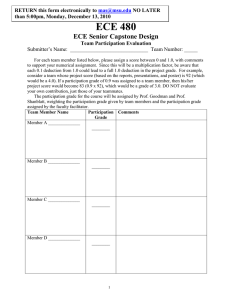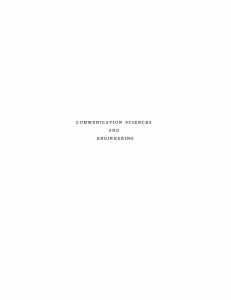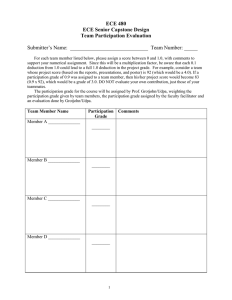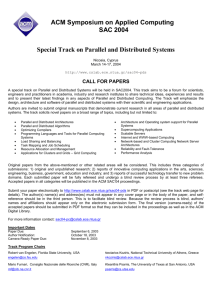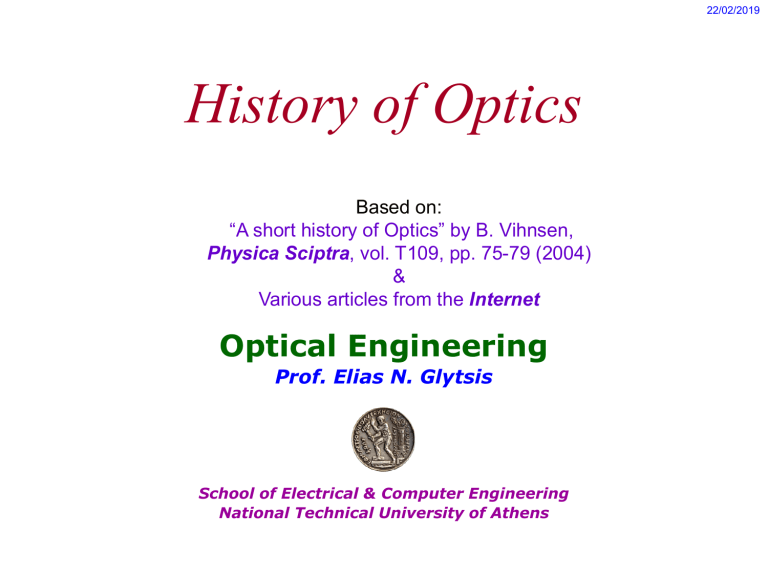
22/02/2019 History of Optics Based on: “A short history of Optics” by B. Vihnsen, Physica Sciptra, vol. T109, pp. 75-79 (2004) & Various articles from the Internet Optical Engineering Prof. Elias N. Glytsis School of Electrical & Computer Engineering National Technical University of Athens Light in Ancient Years Ra: Egyptian God of the Sun (~5000BC) Bible: “Let there be Light” (day) (~1500-1060BC) Ancient Greeks: Pythagoras’ (569-475BC), Followers, Democritus’ (460-370BC) Followers, Empedocles’ (494-434BC) Followers Prof. Elias N. Glytsis, School of ECE, NTUA 2 ~ 400 B.C. Democritus: developed the concept of atoms; attempted to explain perception and color. ~ 350 B.C. Aristotle: questions of perception; rejected the Euclidian theory that vision was solely due to rays emanating from the eyes and "touching" the object. ~ 300 B.C. Euclid: In his Optica he noted that light travels in straight lines and described law of reflection. He believed that vision involves rays going from the eyes to the object seen. ~ 250 B.C. Archimedes: setup of optical weapons/defense machines for the king of Syracuse (Sicily) to defend the city against the Romans; very much involved in Catoptrics (reflection on surfaces). ~ 30 A.D. Seneca: wrote about magnifying effect of liquids in transparent vessels. Prof. Elias N. Glytsis, School of ECE, NTUA Democritus (460BC-370BC) Aristotle (384BC-322BC) Euclid (325BC-265BC) Archimedes (287BC-212BC) Seneca (4BC-65AD) 3 ~ 60 A.D. Hero of Alexandria: Light follows the shortest path, law of reflection. ~120 A.D. Ptolemy: wrote a five volume textbook on optics; observed the small angle approximation of Snell’s law (i.e. the ratio of the angle of incidence vs. angle of refracted light is constant). ~1000 A.D. Alhazan (Abu Ali Hasan Ibn al-Haitham): investigated reflections from spherical & parabolic mirrors, disproved Ptolemy’s refraction law; disagreed with Euclidian theory of vision; discussed atmospheric refraction; explained the increase in apparent size of the sun and moon near the horizon; attempted to measure the height of the atmosphere. Prof. Elias N. Glytsis, School of ECE, NTUA Hero (10AD-70AD) Ptolemy (90AD-168AD) Alhazan (965AD-1040AD) 4 ~ 1220 A.D. Robert Grosseteste: University of Oxford: Theory should be combined with experimental observations as basic scientific method; He believed colors are related to light intensity. Share view with earlier Greeks that vision involves emanations from the eye. ~ 1250 A.D. Roger Bacon: insisted on experimental observations as basic scientific method; carried out experiments with lenses and mirrors; described principles of reflection and refraction. Finite speed of light. He attributed rainbow to sunlight reflection by raindrops. ~ 1270 A.D. Witelo (or Vitelo) of Silesia: completed Perspectiva which was a standard text on optics for several centuries. Parabolic mirrors construction, refraction (angle of refraction non proportional to angle of incidence) Prof. Elias N. Glytsis, School of ECE, NTUA R. Grosseteste (1175 AD-1253 AD) R. Bacon (1214AD-1294AD) Witelo of Silesia (1230 AD-1275 AD) 5 ~ 1600 Galileo Galilei: learned in 1609 of the invention of the telescope (by a Dutch eye glass manufacturer - Hans Lippershey); build his own devices with magnification up to 30 times, i.e. the most powerful instruments of his time; thus enabled the discoveries that established the Copernican system. ~ 1600 Johannes Kepler: was among the few to accept the Copernican heliocentric astronomy; discovered the laws of planetary motion; provided correct explanation of vision and functions of the pupil, cornea and retina; gave first correct explanation of how eyeglasses work; changed the setup of Galileo's telescope by concave lenses (telephoto lens). ~ 1621 Willebrord van Royen Snell: found experimentally the law of refraction; Rene Descartes: described Snell’s law for the first time involving sinus terms (i.e. the form we are used to). W.van R. Snell (1580-1626) Prof. Elias N. Glytsis, School of ECE, NTUA G. Galilei (1564-1642) J. Kepler(1571-1630) R. Descartes(1596-1650) 6 ~ 1657 Pierre de Fermat: postulated the principle of shortest propagation times; deduction of the refraction law from Fermat’s principle. ~ 1665 Francesco Maria Grimaldi: described diffraction of light. ~ 1665 Robert Hooke: investigated interference effects at thin films; his ideas triggered the wave theory of light. ~ 1666 Isaac Newton: (among many other achievements) investigated dispersion (e.g. at prisms) and the spectrum of white light; developed the particle theory of light; worked on the correction of lens errors (but did not believe in the possibility of achromats); developed mirror telescopes. P. Fermat (1601-1665) R. Hooke (1635-1703) I. Newton (1642-1727) ~ 1678 Christiaan Huygens: developed the wave theory of light; introduced the concept of elementary waves; applied the theory to explain the lower speed of light in a dense medium, refraction and birefringence; he also observed polarization in birefringent crystals. Prof. Elias N. Glytsis, School of ECE, NTUA F. M. Grimaldi (1618-1663) C. Huygens (1629-1695) 7 ~ 1676 Ole Christensen Römer, proposed an experiment (by astronomic observation of a total eclipse of the sun, and of Jupiter satellite Io eclipses) to prove and determine the finite speed of light O. C. Romer(1644-1710) ~ 1670 after the invention of the microscope in 1595 (by Zacharias Janssen), Antonie van Leeuwenhoek improved the concepts and developed powerful devices (magnification up A. Val Leeuwenhoek (1632-1723) Z. Janssen(1580-1638) to 300 times) ~ 1730 Chester Moore Hall, developed an achromatic lens by trying different combinations of flint and crown glass; John Dollond copied and patented Hall‘s concept to start commercial production C. M. Hall (1703-1771) ~ 1800 Carl Friedrich Gauss: (among many other achievements) directed an astronomical observatory, developed a mathematical description of lenses (“Gaussian optics”), i.e. provided the mathematical basis for optical imaging theory; made contributions to the theory of electromagnetism Prof. Elias N. Glytsis, School of ECE, NTUA C. F. Gauss (1777-1855) 8 ~ 1802 Thomas Young: supported the wave theory of light and postulated the interference principle, i.e. two light fields show constructive or destructive interference when coherently superimposed; introduced the idea of light as a transversal wave (so far understood as longitudinal, e.g. as sound waves) ~ 1815 Augustine Jean Fresnel: supported the wave theory of light; explained the straight propagation of light in homogeneous, isotropic media; calculated diffraction patterns at apertures; deduced eqns. for the amplitudes of reflection and refraction (Fresnel eqns.) ~1814 Joseph von Fraunhofer: developed telescopes, invented the spectroscope, investigated diffraction at optical gratings (Fraunhofer diffraction), and detected absorption lines in the solar spectrum (Fraunhofer lines) Prof. Elias N. Glytsis, School of ECE, NTUA T. Young (1773-1829) A. J. Fresnel(1788-1827) J. van Fraunhofer (1787-1826) 9 ~ 1845 Gustav Kirchhoff: (among other achievements) developed the (Kirchhoff) radiation law, and contributed to spectroscopy (e.g. investigation of Fraunhofer lines). ~ 1849 Michael Faraday: (among other achievements) demonstrated the rotation of the polarization of light in a medium, manipulated by a magnetic field (Faraday effect). ~ 1849 Hippolyte Fizeau & Leon Foucault: measured the speed of light, for the first time in a earth-bound experiment (also proposed by F. Arago). M. Faraday(1791-1867) ~ 1864 James Clerk Maxwell: (among other achievements) developed the electromagnetic (classical wave) theory of light; deduced the transversal characterof light and the speed of light. Prof. Elias N. Glytsis, School of ECE, NTUA G. Kirchhoff (1824-1887) H. Fizeau (1819-1896) L. Foucault (1819-1868) J. C. Maxwell (1831-1879) 10 ~ 1881 Albert Abraham Michelson: determined experimentally the speed of light with large accuracy; invented the Michelson interferometer; disproved the existence of an ether (i.e. a medium, which was supposed to work as a carrier for light) light travels through vacuum without the need for a carrier medium. A. A. Michelson (1852-1931) ~ 1887 Ernst Abbe: developed the theory of optical images in a microscope, design and production of optical instruments based on scientific theory rather than try-and-error; investigated lens errors. E. Abbe (1840-1905) ~ 1888 Heinrich Hertz: designed a detector and an oscillator (Hertz dipole) for EM waves, to demonstrate reflection and refraction in the laboratory; EM wave properties are the same as those of light; light is an EM wave; Hertz also discovered the photo-electric effect. Prof. Elias N. Glytsis, School of ECE, NTUA H. Hertz(1857-1894) 11 ~ 1891/1892 Ludwig Mach and Ludwig Zehnder: described (separately) what is known as a MachZehnder interferometer (find changes in refractive index – density changes is gas flows). L. Mach (1868-1951) L. Zehnder (1854-1949) W. Wien (1864-1928) Lord Rayleigh (1848-1919) ~ 1896 Wilhelm Wien : described how the spectral distribution of radiation of a blackbody varies with temperature. ~ 1899 Lord Rayleigh (John William Strutt): Explained blue color of the sky and red sunsets due to preferential scattering in the earth’s atmosphere. ~ 1899 Marie P A C Fabry and Jean B G G A Perot: Described the Fabry-Perot interferometer which enabled hih resolution observation of spectral features. Prof. Elias N. Glytsis, School of ECE, NTUA M. Fabry (1867-1945) J. Perot.(1863-1928) 12 ~ 1900 Max Planck: quantum theory of light (beginning of quantum optics); Planck’s black-body radiation law; deduction of the values for Planck‘s constant h. ~ 1905 Albert Einstein: (among other achievements) explained the photo-electric effect; introduced the concept of light quanta (later called “photons”); postulated a constant speed of light (special theory of relativity); contributed to the quantum theory of light (and matter). ~ 1912 Max von Laue: discovered the diffraction of X-rays at crystals; conducted optical experiments to support Einstein’s special theory of relativity. Prof. Elias N. Glytsis, School of ECE, NTUA M. Planck (1858-1947) A. Einstein (1879-1955) M. von Laue (1892-1987) 13 ~ 1924 Louis de Broglie, postulated the existence of matter waves (i.e. defining the beginning of matter wave optics); the wave character of matter was demonstrated by Clinton Davisson and Lester Germer (1926), observing the interference of an electron beam on a Nickel crystal; Claus Jönnson demonstrated the interference of an electron beam in a double-slit experiment (1961). ~ 1931 Ernst Ruska and Max Knoll build the first (transmission) electron microscope, based on the concepts of matter waves and electron optics (e.g. implemented with electro-static and magnetic lenses). V. L. de Broglie (1892-1987) E. Ruska (1906-1988) Prof. Elias N. Glytsis, School of ECE, NTUA C. Davisson (1881-1958) L. Germer (1896-1971) C. Jonsson (1930-) M. Knoll (1897-1969) 14 ~ 1957 Gordon Gould patented the optically pumped-laser, based on the concepts of light amplification (laser physics), developed by Charles Hard Townes, Nicolai Basov, Alexander Mikhaylovich Prokhorov (1954, Nobel prize 1964). G. Gould (1920-2005) N. Basov (1922-2001) C. H. Townes (1915-2015) A. M. Prokhorov (1916-2002) ~ 1957 till today : the invention of the laser pushed a huge amount of research and developments in modern applied optics & optical technologies. Prof. Elias N. Glytsis, School of ECE, NTUA 15 Wave-Particle Duality of Light Particles Waves De Broglie (1924): λ = h / p, h = 6.626 × 10-34 J sec, p = momentum Prof. Elias N. Glytsis, School of ECE, NTUA 16
